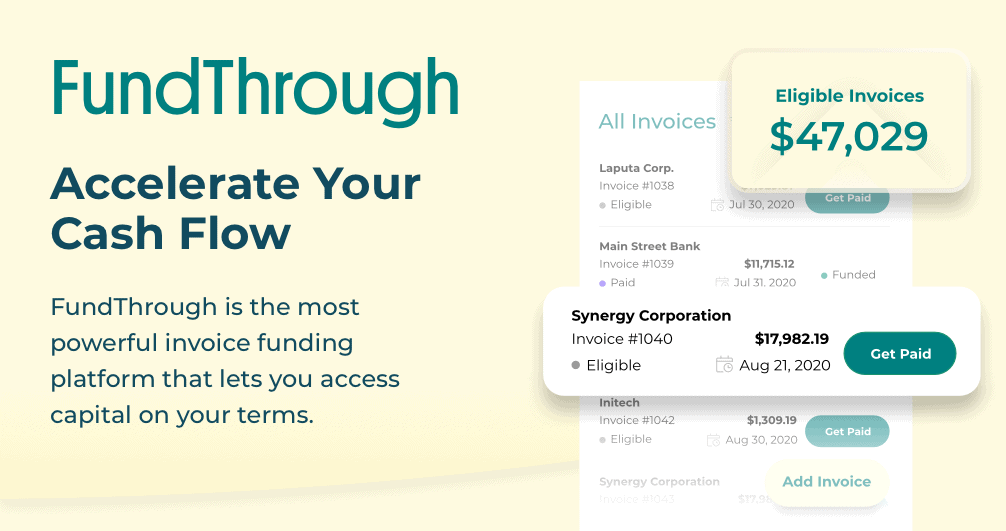No. 3 is a Game-Changing Way to Fund Small Businesses.
You don’t need to be an accountant to understand the importance of cash flow management.
Unfortunately, 69% of small business owners struggle to sleep at night due to concerns about cash flow. That figure comes from a study by Intuit QuickBooks on the State of Small Business Cash Flow.
Cash flow woes are a nasty challenge. They can limit your ability to pay bills, stifle growth potential, force you to take on new debt, or even encourage you to sell a stake in your company in order to raise the working capital necessary to keep your business running smoothly.
They can also limit your ability to accept new clients. The Intuit study also shows that U.S. small business owners have lost an average of $43,493 by losing new projects or new sales due to cash flow problems.
Before any of these worries become a reality, business owners should consider ways to improve cash flow. A variety of best practices can help you get a cash flow boost without the need for new debt, high-interest bank loans, or long waits for slow-paying customers.
As a bonus, you can save time and get back to work, so you don’t have to pass up new projects.
You don’t need an MBA in finance to get started.
You simply need to keep an open mind and an agile accounting strategy. Let’s get started.
Cash Flow Boosting Tip No. 1. Send Out Invoices Immediately With the Right Attributes
It seems like a no-brainer that you should ask for a customer’s payment as soon as a project is complete.
But many small businesses procrastinate or straight-up forget or fail to send out a bill. It is not safe to assume that a customer will simply pay you upon delivery.
It is therefore the seller’s responsibility to send an invoice.
The optimal time to send out an invoice is the moment that a job is complete and fresh on your mind.
Remember when you were younger, and your parents told you to put out your clothes for school the next day? Well, some of us didn’t do that either, but you would end up forgetting a belt, selecting mismatching socks, or your shirt would be on backward. Those scenarios might have been just a little embarrassing.
However, this situation is much worse because it involves your money.
Take the extra five minutes when you’re done, fill out the invoice, and send it along immediately.
Remember, it’s not just about timing. There are other attributes to an invoice that you must incorporate to increase the speed and probability of payment.
- According to Due.com, sellers are three times more likely to get paid if they add their company’s logo to the invoice;
- Sellers are 1.5 times more likely to get paid if they put the payment terms on the invoice; and,
- Sellers are eight times more likely to get paid if they put a due date on the invoice (1 out of 4 invoices do not carry a due date, according to the study).
So, send your invoices early and often.
Consider digital software like QuickBooks Online to manage and expedite the process.
And if you don’t hear back from emails about payment, pick up the phone and call them.
Tip No. 2. Demand Late Payments With Interest Penalties
As we noted, you’re eight times more likely to get paid if you put a Due Date on your invoice.
If you need further evidence of why this number matters, consider the following statistic:
Of sellers who do not receive a payment within 90 days, just 18% ever receive full payment.
Tip No. 3. Use Invoice Factoring Services to Get Paid Faster
If you’re a small business owner, you have enough on your plate. Chasing payments doesn’t represent the best use of your time. The thing that most business owners don’t know, however, is that they can get an instant cash flow boost in exchange for their outstanding customer invoices.
An invoice, by definition, is a financial instrument that can be exchanged as collateral for loans or instant working capital.
With invoice factoring, you sell unpaid invoices to a company like FundThrough for the money you need.
Invoice factoring services allow you to improve cash flow management and determine the time of payment on your terms. With FundThrough, you can get a cash flow boost quickly.
Sadly, not every company takes advantage of this benefit. According to Intuit, roughly one-third of American small business owners say they have at least $20,000 in unpaid invoices.
And the average amount of outstanding receivables for U.S. small businesses is $53,399, according to the same report.
Invoice factoring can be a great cash flow boost, as can invoice financing, which typically costs less and is used for smaller invoice payments.
This is a very powerful solution for small business owners looking to fund their growth or just to have peace of mind and sustainable cash flow.
If you don’t want to pick up the phone or you don’t have time to chase down eligible payments, invoice factoring offers an innovative solution to get a cash flow boost. Give it a try today. Simply upload an eligible invoice and get your funds deposited directly to your business bank account in just days upon approval.
Tip No. 4. Lease Products and Equipment to Reduce Upfront Costs
If you’re a startup company and you’re hiring employees, remember – you don’t need to load up on high-end computers and expensive equipment for cash or on the company credit card.
Leasing supplies, equipment, and real estate are indeed more expensive than buying them over the longer term, and can give you a cash flow boost when you’re starting up. Remember, most startups have an initial cash flow of $50,000 to $100,000 in the bank. According to Intuit QuickBooks, the average startup launches with just $10,000 in the bank.
Leasing equipment allows you to make smaller payments over time. And technology and equipment companies typically have favorable leasing terms that use the equipment as collateral.
Leasing provides several other benefits. The process can improve your business credit score and profile, boost your cash flow over time, and receive a tax write off on the cost of business capital. You can also trade in equipment and devices to ensure you’re using the most up-to-date technology for your business.
Tip No. 5. Request Deposits on Large Orders/Projects
Large orders take more time and resources to fill than smaller ones. Perhaps you need to hire more people to get work done or take on larger inventory levels in order to meet your obligations. Then there’s also the case that you might have to dedicate the bulk of your time to one specific project, which creates opportunity costs for companies focused on one large job.
Consider payment terms that would provide you with the necessary cash flow boost to meet those obligations.
In exchange for a modest deposit upfront, you might be willing to extend payment terms once delivered for the balance of the remaining invoice. At that point, you might consider using invoice factoring or invoice financing to get paid faster and on your terms.
The added benefit is that you’d have an even smaller fee for the cost of using invoice funding tools.
Tip No. 6. Shift to a Bi-Monthly Payment Cycle
If you have employees, the common expectation is that paychecks arrive every two weeks. The problem is that this is a bit old-fashioned and forces you to standardize the Friday for payment each month.
Instead of every two weeks (or 26 payment cycles), switch over to bimonthly payments on the 15th and last day of the month. This reduces your payment cycle to 24 events and helps manage cash flow more predictably.
Also, a bi-monthly payment schedule is widely considered a more beneficial payment schedule for employees as it provides a more consistent distribution over the year. During ten months of the year, an employee would receive smaller average payments in a 26-payment cycle than in one with 24 payments, as explained by Alexandrite Group.
This strategy gives them an additional cash flow boost too for their own monthly personal expenses.
Tip No. 7. Ditch the Checkbook to Get a Cash Flow Boost
Not only should you pay your bills electronically (that includes utilities), but you should also use the calendar to take advantage of technological benefits. Online payments allow you to buy a little more time and even earn a few benefits in the process.
With electronic payments, you can wait until the last day of your billing cycle to make your eligible payments. Also, you can use a business credit card that has up to a three-week payment grace period to extend your payment cycle even further.
You might even be able to get a business credit card that pays benefits like miles or earns cash back from purchases. Some business credit cards will even offer a 0% introductory APR for a certain period of time.
The Bottom Line on Cash Flow Boost
Cash flow is the lifeblood of a small business. Using the right invoice and payment strategies can dramatically boost your cash flow and give every small business owner the peace of mind they deserve.
To learn more about cash flow basics and important definitions for small businesses, check out our Ultimate Cash Flow Guide.
Want to get started with funding an invoice for your own cash flow boost? See if you qualify now.
Suggested Readings

The 10 Best Banks for Small Businesses in 2025
READ

Same-Day Business Funding: 3 Best Options & Tips for Success
READ

Strong Canadian Support is Critical for Small Businesses to Survive—And Even Thrive—Amid Trump’s Tariff Chaos
READ

7 Best No Credit Check Business Funding Options: Success Tips for SMBs
READ

FundThrough Named Best Overall Invoice Factoring Company by Top Business and Finance Outlets
READ

Lima Charlie: Raising $8M in 30 Days to Unlock New Growth Channel
READ
